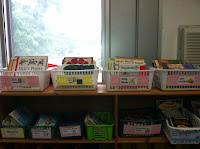In the past each series had it's own basket, with a label and collection of books. Since I am running out of room on my shelves I decided to combine several series in one basket. I tried very hard to choose series that would "go together" - they were a similar reading level and similar interest. For instance, I put the Biscuit and Tiny the Dog series in the same basket. Andy Shane and Little Bill books are displayed together as well.
My Thoughts on Leveling Books
There seems to be a lot of opinions out there on leveling books - so I thought I would add my 2 cents. Here's what I think. It disturbs me to see public librarians and school librarians being asked to put together lists of books according to reading levels such as Fountas and Pinnell or Lexile. And now it seems publishers are getting in on the leveling craze and using it as a marketing tool. What adult would go to a book store or library and select books based on a reading level? And children are no different. If we want our children to become readers we need to help them find books they will enjoy reading. I'm afraid this leveling craze is due to parents requesting a list of books that are on their child's reading level. So, how did they get so wrapped up in their child's guided reading level? Us. Their child's teachers. So many of my colleagues report the reading level to parents at conferences, and some school districts require that it be on the report card. I think this is a big mistake. Guided reading levels are meant to be used as a teaching tool - one piece of the assessment puzzle we use in teaching reading.
Please don't get me wrong - I use Fountas and Pinnell guided reading levels as part of my assessment. And book levels can be helpful when selecting books for my class library and helping students select books to read. But I don't label books with levels and I certainly don't label students with a level! I have also found that my students' reading levels are not hard and true - depending on their interest and background knowledge I have found individual students often fall into a range of reading levels. And more than once a student has proven me wrong and was able to read a book that I thought was too challenging, but the student wanted to read it bad enough they did! But what is more important for us as teachers, is understanding the characteristics of the different levels of books and knowing what readers will have to know how to do to successful read and understand a particular level of book. Once a teacher understands this, you can look at most books and know if it is a good fit for your reader. What is most important for young readers is that we teach them how to find books they can read independently and will enjoy. And that is part of the art of teaching reading!
Be sure to read Pernille Ripp's and Professor Nana's posts regarding the recent craze on leveling books!
Favorite Series for Second Grade


 I also have collections of reading series such as Scholastic Readers, Hello Readers and I Can Read Series. My students often have a hard time re-shelving these books and they end up in the wrong basket. So this year I decided to color code the collections. For example, the Scholastic Reader books will get a red sticker so students will know which basket to return the book.
I also have collections of reading series such as Scholastic Readers, Hello Readers and I Can Read Series. My students often have a hard time re-shelving these books and they end up in the wrong basket. So this year I decided to color code the collections. For example, the Scholastic Reader books will get a red sticker so students will know which basket to return the book.Here's what my class library looks like in the beginning of the year. I have mostly transitional, early fiction series out. Longer chapter books will be available later as my students get better at selecting books. I have a few baskets of non-fiction out as well, including animal books, plant books and some easy biography. I curtain off parts of the library because my second graders get overwhelmed if I put out too much too soon. The red, blue, green and yellow baskets are my students' "book baskets"- where they keep all of their independent reading materials and reading folder. I also like to put out familiar books from first grade - like song books, ABC books, Eric Carle and Mo Willems. This year I also put out my Peter Brown books since he visited our school last year.

 |
| Under the curtain |
 |
| Non-Fiction Shelves |

What does your class library look like? Do you level your books?

























